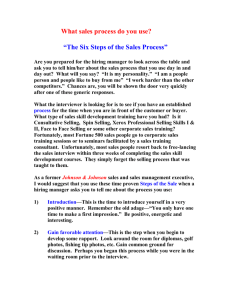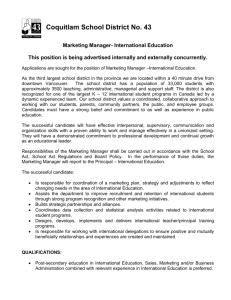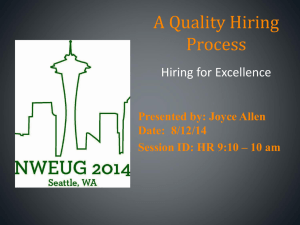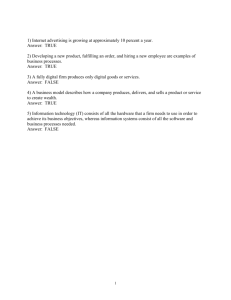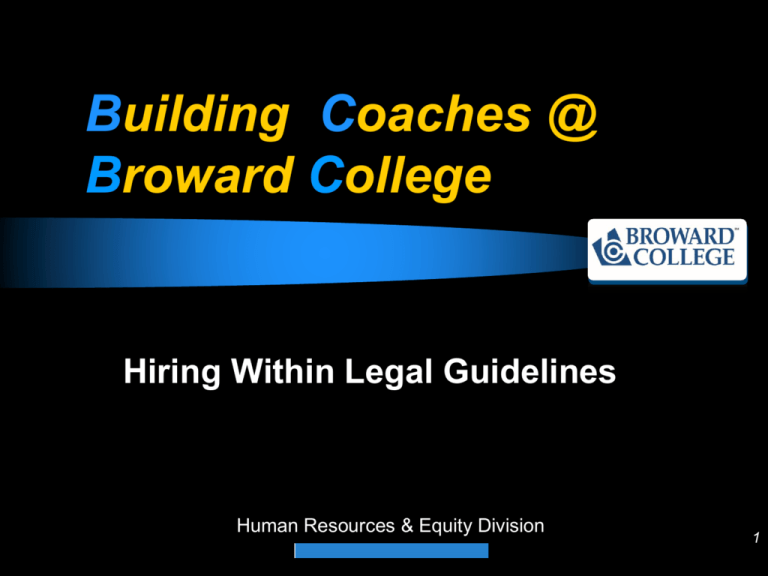
Building Coaches @
Broward College
Hiring Within Legal Guidelines
Human Resources & Equity Division
1
Agenda
Activity/Topic
Welcome, Learning Objectives, Activity
Effective Supervision - Challenges
Employment Laws
Policy Highlights, Documents & Process
Hiring Process
Preparing and Conducting Interviews – Hiring For Attitude
Question & Answer and Evaluation
2
Expected Learning Outcomes
Identify internal and external challenges of supervising.
Identify employment laws that need to be followed when hiring.
Describe Broward College’s hiring process.
Identify filters and barriers that may affect the selection process.
Identify your ‘Brown Characteristics’ to hire for attitude.
Identify specific steps in preparing and conducting interviews.
Convert informational interview questions to behavioral interview
questions.
3
ACTIVITY
To Ask or Not to Ask?
... That is the Question
4
Supervisor’s Role
Serve as college’s
Representative, Eyes and Ears, ‘Front line’
Are aware of good/bad things that occur on
campus
Administer discipline in certain cases
Coordinate with HR investigation of complaints
Understand/implement college
policies/procedures
Ensure employees complete responsibilities
related to College’s mission and strategic
priorities
Supervisor’s Role
Help
create/promote:
Campus/College morale
Positive and professional
relationships
Public image & reputation of
institution
Effective Supervision
Does
not occur naturally
Is skill-based
Requires continuous refinement
Requires understanding of
internal and external challenges
Internal Challenges to Effective
Supervision
Focus on personal goals vs. the
vision/mission
2. Stamina (physical and emotional)
3. Colleague vs. friend
4. Sometimes it’s not always the best
use of one’s skills/strengths
1.
External Challenges to
Effective Supervision
1.
2.
3.
4.
5.
6.
Changing demographics
Leadership transitions
Litigation landscape
New/increased legal compliance demands
Increase in # and complexity of faculty,
staff and student issues
Campus security & workplace safety
The Supervisor’s Challenge:
Commit to ongoing prep & training to ensure
reflective & engaged approach to supervision
Provide support regarding addressing
inappropriate conduct at pre-conflict stage
Communicate effectively
Understand factors that contribute to conflict and
consequences of conflict avoidance
Be consistent!
Some General Tips
Do not supervise in a vacuum - seek
assistance
Evaluate your goals as a supervisor
Set clear boundaries - be fair and
consistent (DITO-DITA)
Seek to understand before seeking to
be understood
Some General Tips
Understand
how to prepare clear,
accurate, & thorough documentation
Know when to seek assistance
Ask more questions
Understand when/how to appropriately
use email
Side Note about Email
The ‘E’ in E-Mail stands for:
Electronic (yes)
And also……
• Evil
• Embarrassing
• Eternal
• Evidence (PUBLIC RECORD)
Keep that in mind before you hit SEND
Employment Laws
14
Employment Law Highlights
Laws
Prohibits discrimination in hiring
based on…
Civil Rights Act (1964, 1991)
… race, religion, color, sex, and national origin
Age Discrimination Act of 1967
… age, 40 or older
Equal Pay Act of 1963
… gender, cannot have unlawful pay differences
Americans with Disabilities Act of 1990
(ADA) and Rehabilitation Act of 1973
… people with disabilities.
Immigration, Reform, and Control Act
(IRCA)
… national origin or citizenship status and hiring
of illegal aliens.
Executive Order 11246
Mandates an affirmative action plan for
government contractors and second tier subcontractors.
Florida State Statute 760
… race, color, religion, national origin, age,
disability (state law)
Human Rights Ordinance, Chapter 16 1/2
… age, marital status, political affiliation,
disability, and sexual orientation (county
ordinance)
15
Legal Protections
Federal Civil Rights
Protect
Other Federal Laws &
Local Ordinances
Race
Disability
Religion
Sex
Age
Pregnancy
Color
Marital Status
National Origin
Sexual Orientation
16
Veteran’s Preference
State Policy (Florida Statutes, chapters 295.07
and 295.085 (2), give preference to eligible
veterans and spouses of veterans in appointment
and retention in positions of public employment.
Veteran’s
Preference
form
DD-214
Meets
minimum
qualifications
Meets
desired
qualifications
Should be
afforded
opportunity
to interview
for position
17
Hiring Policies,
Documents and Process
18
Pertinent Hiring Policies/Procedures
Recruitment, Selection & Assignment of
Personnel
6Hx2-3.02
Recruitment, Selection & Assignment of Faculty
in the Baccalaureate Program.
6Hx2-3.06
6Hx2-3.47
Loyalty Oath, Security Background Check, and
Fingerprinting of Employees
6Hx2-3.06
ADA Accommodation in Employment
6Hx2-3.36
Equal Opportunity
6Hx2-2.15
Employee Separation and Exit Interview
6Hx2-3.13
19
Pertinent Hiring Policies/Procedures
Policy on Total Rewards Program for PTS
& Administrator
6Hx2-3.45
Policy on Total Rewards Pay Adjustments for
PTS & Administrator
6Hx2-3.46
Position Classification Plan
6Hx2-3.24
Annual Adoption of Salary Schedule
6Hx2-3.27
Award of Continuing Contract
6Hx2-3.52
20
Recruitment Policy Highlights
Composition of Screening Committee
Confidentiality
Structured Interview
Behavioral-based Questions
21
Background Check Process
Background Check – online
process
Reference Check
22
Hiring Timelines
Position Type
Administrator
Faculty
Professional Technical
Staff (PTS)
Timeline
75 days
End of Term II
42 days
23
Hiring Timelines
Strategic Plan 2014 – 2017
Goal 3 – Strategy 3.2:
Attract, retain and develop diverse
academic and student affairs leaders
in instruction and student success.
24
Role of Screening Committee
Review
Evaluate
Recommend
25
Role of Screening Committee
May
orally rank the candidates;
Submit
names in alphabetical order to
hiring manager;
May
recommend to re-open/re-advertise
the job announcement;
26
College Records - Florida Public
Records Act
Requires
public records be retained and
public be given access to the records.
Retention varies depending on type of
record.
Applications are retained for not less
than two years.
27
Hiring Documents
28
Form I-9
Purpose
• Document new employees authorized to work in US
• Comply with Department of Homeland Security
Employees must present original
documents
Employers are responsible for
completing and retaining the I-9
Illegal to discriminate because of
individual's national origin or citizenship
status.
29
Form I-9: Lists of Acceptable
Documents
LIST “A” (select one)
Documents that Establish Both Identity
and Employment Eligibility
OR
LIST “B” AND LIST “C” (select one from each)
List B:
List C:
Documents that Establish Documents that Establish
Identity
Employment Eligibility
30
Form I-9 – In Workday
Electronic Form
Employees must complete Section I –
must provide original documentation
Human Resources completes Section II
31
Required Training for New Hires
Preventing
Sexual Harassment (PSH)
Preventing Employment Discrimination
(PED)
Family Educational Rights & Privacy Act
(FERPA)
In addition – Faculty complete
Attendance Verification
32
Hiring Process
33
Online Employment System
Process Flow
Electronic Sourcing
Review of advertising plan
Applicant status
Hire
34
Hiring Full-time Regular Employees
1
2
• Update job profile with compensation
department
• Advertise position online
3
• Post for internal or external candidates
(per Policy)
4
• Create search committee
35
Hiring Full-time Regular Employees
5
6
7
8
•Search committee recommends
candidate(s) – lists in alpha order
• Hiring manager recommends one
candidate to Sr.VP/VP/Campus
President
•Background check prior to offer
•No offers extended until notified by the
Division of Human Resources/Equity
36
How do I create a new full-time,
regular position?
1
2
3
4
5
• Create job description and discuss with
Compensation
• Compensation evaluates & classifies
• Budget confirms funding
• Advertise the position
• Begin the search process
• Repeat steps 4-8 above.
37
How do I create and fill a
temporary, full-time position?
1
• Same as number 2 above, except that
funding is temporary
2
• Candidates may be appointed to
temporary positions.
3
4
5
• May or may not be advertised
• An end date needs to be identified
• Temporary employees still need to meet
requirements of job
38
TRS Hiring Guidelines
New Hires
Hiring
within the range (Policy, 6Hx2-3.46)
Quartiles
Process
Interim Appointments (Policy, 6Hx2-3.02)
Duration
Process
39
B R E A K
40
Identifying Filters/Barriers
During Selection
41
Biases
Cultural
Lenses
Filters/
Barriers
Stereotypes
Assumptions
42
Dynamics of Diversity
STEREOTYPE
PREJUDICE
DISCRIMINATION
• Preconceived
and
Oversimplified
generalization
about a group
• Set of Rigid and
Unfavorable
Attitudes or
Beliefs toward a
particular group
• When we ACT
on our
Prejudice by
giving
differential
treatment.
43
Mistakes to Avoid When Evaluating
the Candidates
Gut Feeling
Halo Effect
Similar-to-Me
Contrast Effect
First Impressions
44
Identifying Filters/Barriers Activity
Help Desk
Customer
Representative
Associate
Dean
Enrollment
Services
45
Preparing to Conduct an Interview
Prepare job-related questions that are
legal and help identify the qualified
candidates
Screen resumes for job related criteria
Identify reliable indicators for future
performance
GROUP DISCUSSION – THINK BACK
46
Hiring for Attitude
(by Mark Murphy)
47
Hiring for Attitude
20,000 new hires were tracked over a
three year period
46% failed within first 18 months (WHY?)
got
fired
received poor performance reviews
were written up
48
Hiring for Attitude
Top Five Reasons Why New Hires Fail
1.
2.
3.
4.
5.
Coachability
Emotional Intelligence
(89%)
Motivation
Temperament
Technical Competence (11%)
49
‘Brown Shorts’ Concept
Refers to the unique
attitudinal characteristics
that make your
institution/dept. different
from all others.
50
Characteristics of Low Performers
Blaming
Me-first
Negativity
Dramatic
Stir-up Trouble
Routinely wants individual recognition
51
Characteristics of High Performers
Highly Collaborative
Self-directed
Take Risks or don’t take risks
Sense of Humor
Class and Poise
Resilient, emotionally sensitive to others
52
Selecting your ‘Brown Shorts’
Characteristics
The 3-3-3 Exercise
Write down in behaviorally
specific ways the attitudinal
characteristics of your three best
and three worst employees over
the past three years.
53
Examples of ‘Brown Shorts’
Characteristics…
Identify the department culture
Department is highly collaborative
Employees are respected individuals
Employees accept total responsibility for their
work without excuses
Ideas are freely shared
54
Creating your ‘Brown Shorts’
Questions (Activity)
A four-step process:
1.
Pick your ‘Brown Shorts’ characteristics
2.
Identify a situation to elicit ‘Brown Shorts’
characteristic
3.
Ask your question…. “Could you tell me
about a time you……(insert the situation)”
4.
Leave the question hanging….
55
Examples of Inadequate
Questions
Avoid superficial and easily-gamed questions:
1.
Tell me about yourself?
2.
What are your strengths?
3.
What are your weaknesses?
4.
What would you do if (hypothetical)?
5.
You have good teamwork skills, right? (leading)
6.
What do you like to do for fun?
56
REMINDER
If it is not jobrelated, do not ask it!!
57
Behavioral Interviewing
“Past behavior predicts
future behavior”
58
Advantages of Behavioral
Interviewing
Eliminates
misunderstanding
about
applicant’s
past
experience
Prevents
personal
impressions
from affecting
evaluation of
the applicant
Reduces
applicant
“faking”
59
Formulating Behavioral
Questions
Determine the
“brown shorts”
behaviors,
characteristics,
or skills
What is it
about these
behaviors,
characteristics,
or skills
you need
to know?
Construct
each
question
with the
three ERO
components
60
Data Gathering
xperience The background or context in which the
candidate took action.
ole
What the candidate said or did in response
to the situation and how they said or did it.
utcome –
The effect of the candidate’s actions.
61
Skills/Qualifications:
Analytical Ability (example)
EXPERIENCE
• Could you
describe the
types of
financial
reports you
prepared on
a previous
job?
ROLE
• How did
you collect
and analyze
the data?
OUTCOME
• How were
the reports
used and
what effect
did they
have on
your unit?
62
Skills/Qualifications: Initiative
EXPERIENCE
• Could you
describe a
time you had
to take on a
task that your
supervisor
would have
normally
handled?
ROLE
• What steps
did you
take?
OUTCOME
• What was
the result?
63
Converting Informational Questions to
Behavioral ‘Brown Shorts’ Questions
Informational Questions
Behavioral ‘Brown Shorts’
Questions
How would you handle a
difficult customer, student,
colleague?
Could you please describe a
time when you dealt with a
difficult student?
What would you do if you
needed help to complete an
assignment/task?
Could you tell me about a
time when you didn’t know a
specific procedure on a
past job?
64
If you can do it here,
you can do it on the job tomorrow!
Activity
List three interview questions you
most commonly use.
Convert all three to behavioral
questions; focus on gathering
information regarding their Experience
(situation), Role (action) and Outcome
(result)
65
Interview Preparation Steps
66
The Interview Process
1
2
3
• Gather all relevant information
• Greet the candidates
• Present a positive image of the institution
4
• Have copies of the job description available to
share with the candidates
5
• Be prepared to describe a “day in the life” of
the position
67
The Interview Process continued
6
• Ask all candidates same job-related
questions
7
• Allow candidate to talk majority of
interview
• After Interview:
8
• Answer candidate’s question(s)
• Explain next steps in the search process
• Thank candidate for interest in the position
68
Applicants’ Concerns
Job Requirements
Job setting
Opportunities to
demonstrate ability
& talents
Work
atmosphere/culture
Initial assignments
Training
Benefits
69
The Close
“We/I enjoyed talking with you. Thank
you for your time…do you have any
questions we have not already
addressed?”
“We’ll/I’ll be reviewing all the candidates
and making a recommendation by (time
frame) and the candidates will be notified
of the status of the search.”
70
Role Play
1. Choose a partner to interview.
(decide who plays interviewer first)
2. Start with the greeting
3. Use your three behavioral questions
4. Use a closing statement
5. Change roles and role-play again
71
Broward College Specific Documents
Applicant Rating Grid
Telephone Interview Grid
On Campus Interview Grid
Employment Reference/Evaluation Form
General Interviewing Guidelines & Tips
Located in Participant Guide
72
Let’s Recap:
Create
job descriptions that clearly
define the credentials and essential
functions
Follow
the recruitment policy and
procedures
Maintain
confidentiality
73
Let’s Recap:
it’s not job-related, do not ask it
Reference checks done by hiring
manager
If
No
offers made until approval is
received from the Human
Resources/Equity Division
74
Let’s Recap:
When
in doubt, contact Human
Resources - Recruitment office
Separations
(resignations,
retirements, terminations) –
complete Separation Check List
(Policy 6Hx2-3.13)
75
Questions?
and
Evaluation
76


